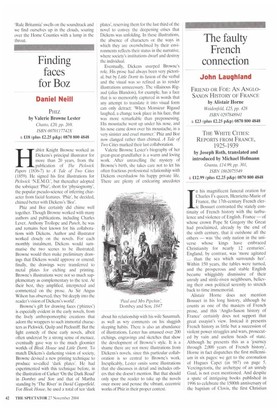Finding faces for Boz
Daniel Neill
P1-Hz by Valerie Browne Lester Chatto, £20, pp. 269. ISBN 0070_117742X & £18 (plus £2.25 p&p) 0870 800 4848 Hablot Knight Browne worked as Dickens's principal illustrator for more than 20 years, from the publication of The Pickwick Papers (1836-7) to A Tale of Two Cities (1859). He signed his first illustrations for Pickwick `N.E.M.O.', but thereafter adopted the sobriquet Phiz', short for 'physiognomy', the popular pseudo-science of inferring character from facial features. Phiz', he decided, chimed better with Dickens's 'Box'.
Phiz and Box certainly did chime well together. Though Browne worked with many authors and publications, including Charles Lever, Anthony TroRope and Punch, he was and remains best known for his collaborations with Dickens. Author and illustrator worked closely on the novels. For each monthly instalment, Dickens would summarise the two scenes to be illustrated; Browne would then make preliminary drawings that Dickens would approve or emend; finally, the drawings were transferred to metal plates for etching and printing. Browne's illustrations were not so much supplementary as complementary to the text. At their best, they amplified, interpreted and commented on the prose. As Sir Angus Wilson has observed, they 'bit deeply into the reader's vision of Dickens's world'.
Browne's gift for drawing faces ('phizzes') is especially evident in the early novels, from the lively anthropomorphic creations that adorn the wrappers to such immortal characters as Pickwick, Quilp and Pecksniff. But the light comedy of these early novels, albeit often undercut by a strong sense of menace, eventually gave way to the much gloomier worlds of Bleak House and Little Dorrit. To match Dickens's darkening vision of society, Browne devised a new printing technique to produce so-called 'dark plates'. He had experimented with this technique before, in the illustration of Carker 'On the Dark Road' in Dombey and Son and that of Martha standing by 'The River' in David Copperfield. For Bleak House, he used a total of ten 'dark
plates', reserving them for the last third of the novel to convey the deepening crises that Dickens was unfolding. In these illustrations, the absence of characters or the ways in which they are overwhelmed by their environments reflects their status in the narrative, where society's institutions dwarf and destroy the individual.
Eventually, Dickens usurped Browne's role. His prose had always been very pictorial, but by Little Dorn't its fusion of the verbal and the visual was so refined as to render illustrations unnecessary. The villainous Rigaud (alias Blanciois), for example, has a face that is so memorably captured in words that any attempt to translate it into visual form can only detract: 'When Monsieur Rigaud Laughed, a change took place in his face, that was more remarkable than prepossessing. His moustache went up under his nose, and his nose came down over his moustache, in a very sinister and cruel manner.' Phiz and Box now clanged rather than chimed. A Tale of Two Cities marked their last collaboration.
Valerie Browne Lester's biography of her great-great-grandfather is a warm and loving work. After unravelling the mystery of Browne's birth, she takes care not to let his often fractious professional relationship with Dickens overshadow his happy private life. There are plenty of endearing anecdotes about his relationship with his wife Susannah, as well as wry comments on his sluggish sleeping habits. There is also an abundance of illustrations. Lester has amassed over 200 etchings, engravings and sketches that show the development of Browne's style. It is a shame there are not more illustrations from Dickens's novels, since this particular collaboration is so central to Browne's work. Inexplicably, Lester omits some illustrations that she discusses in detail and includes others that she doesn't mention. But that should only spur the reader to take up the novels once more and peruse the vibrant, eccentric works of Phiz in their proper context.


















































































 Previous page
Previous page